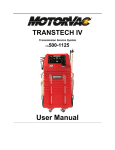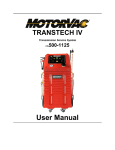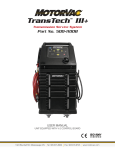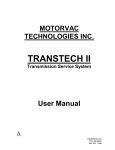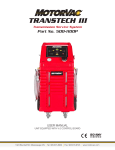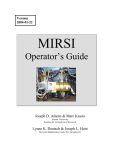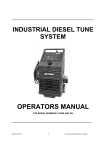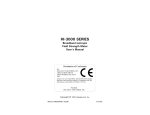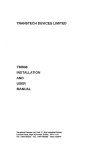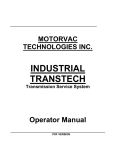Download TransTech III Manual
Transcript
MOTORVAC TECHNOLOGIES INC. TRANSTECH III Transmission Service System User Manual modified pdf file version. Table of Contents Introduction.......................................................................................................................................... iii Overview................................................................................................................................................ 4 System Features and Functions ...................................................................................................... 1-1 Control Panel Features and Functions ......................................................................................... 1-2 Left View ....................................................................................................................................... 1-3 Right View…………………………………………………………………………………………………1-4 Theory of Operation………………………………………………………………………………………1-5 Safety Information ............................................................................................................................. 2-1 Before You Begin .............................................................................................................................. 3-1 First Time Operation ..................................................................................................................... 3-1 Transmission Service Procedure .................................................................................................... 4-1 Frequently Asked Questions............................................................................................................ 5-1 Troubleshooting and Additional Help ............................................................................................. 6-1 Appendix A - Maintenance............................................................................................................... A-1 Maintenance Procedures ..............................................................................................................A-1 Cleaning the Unit’s Filter Screen ………………………………………………………………………A-1 Maintenance Record.....................................................................................................................A-3 Appendix B - System Accessories ................................................................................................. B-1 Adapter Kits ………………………………………………………………………………………..……..B1 Appendix C - Parts ........................................................................................................................... C-1 External Parts .............................................................................................................................. C-1 Ordering Parts……………………………………………………………………………………………C-1 Introduction Congratulations on your selection of the TRANSTECH III Transmission Service System. By choosing this product, you are acquiring the most technologically advanced method available for automatic transmission service and fluid exchange. The TRANSTECH III System is a self-contained system; designed to connect to any automatic transmission through it’s cooling system lines. Once the unit is connected, it can be used to drain the fluid from the vehicle’s transmission for filter replacement and/or to completely exchange the transmission fluid with new fluid, without removing the vehicle’s transmission fluid pan. With the engine idling, the unit will receive the used fluid expelled by the vehicle’s transmission fluid pump through one of the hoses connected to the transmission cooling system, and supplies new fluid through the second hose connected to the other side of the disconnected transmission cooling line. It is recommended that a vehicle’s transmission lubrication system be serviced every 15,000 miles (Or according to the vehicle owner’s manual) to obtain the highest lubricant protection, to reduce friction from internal transmission components, and thus increase the efficiency and life span of the transmission to it’s maximum. Please study this Operators Manual to become thoroughly familiar with the TRANSTECH III Transmission Service System. IMPORTANT The TRANSTECH III Transmission Service System is designed to work EXCLUSIVELY with Automatic Transmission Fluid. Use of any chemical during this process may cause operational failure of the TRANSTECH III System and voids the manufacturer’s warranty. See warranty card for details. Overview This manual contains all the information you need to use the TRANSTECH III System. Please make sure all technicians using the unit read this manual and have it within easy reach whenever the unit is being used. The following is a quick reference to the information in this manual: System Features and Functions This chapter describes the TRANSTECH III Transmission Service System’s Switches, Lights and Connections. Safety Information Adhere to the safety guidelines in this chapter at all times! Before You Begin Follow the instructions in this chapter before using the unit for the first time. Service Procedure This chapter contains step-by-step setup and service procedure for using the unit to drain the vehicle’s transmission oil pan and/ or to exchange the fluid completely. Frequently Asked Questions Helpful information to common questions. Troubleshooting and Additional Help Turn to this chapter in the unlikely event you have problems with your TRANSTECH III System or need additional help. Appendices - Maintenance, Accessories, and Parts The appendices contain routine maintenance procedures for the TRANSTECH III System, such as cleaning the filter screen, lists of available accessories, replacement parts, and the Material Safety Data Sheet. System Features and Functions The front of the TRANSTECH III cabinet contains the control panel, the fluid fill neck for adding new transmission fluid, and the fluid level windows . Front View - Control Panel Features and Functions A G B H C D E I F J A. Change Fluid Begins service - Starts exchanging new fluid for used fluid. NOTE: With DRAIN, FILL, and ENGINE START light on, service is in progress. B. Drain Drains fluid from vehicle’s transmission. When performing filter change, an alarm will sound when the transmission is empty. C. Low Vehicle Fluid Illuminates when fluid from the vehicle in service is low or empty. D. Complete Illuminates when service is complete or the stop button has been pressed E. Engine Start Flashes when the vehicle’s engine needs to be started, Is on solid when the vehicle’s engine is running and good flow is seen from the transmission. F Engine Stop Flashes when the vehicle’s engine needs to be stopped, Is on solid when the vehicle’s engine is OFF. G. Fill (Top Off) Adds fluid to the transmission. See page 1-5 for more information. H. Low Clean Fluid Illuminates when clean fluid in the unit’s clean tank is empty. I. Stop Stops alarm if alarm is sounding. Stops pump if alarm is not sounding. J. Empty Waste Empties used waste fluid from unit’s waste tank. Left View D A E B C A. Adapter Tray Stores machine’s service adapters. B. Disposal hose Is inserted into the shop’s fluid recycling container or into a suitable container for proper disposal of used transmission fluid. C. Quick Coupler Secures the unit’s Return hose connection to the adapter connected to the vehicle’s transmission‘s cooling system. D. Fill neck Access for filling new transmission fluid into unit’s clean tank. E. Return Hose Connects to the transmission through its cooling system. F. Disposal hose check Valve (Not Shown) Prevents excessive drainage from waste hose, opens automatically when EMPTY WASTE button is pushed. Right View C D A B A. Output Hose Connects to the transmission’s cooling system. B. Quick Coupler Secures the unit’s output hose connection to the adapter connected to the vehicle’s transmission’s cooling system. C. Serial plate Identifies the unit’s model and specific manufacturer’s production number. D. Battery Cables Positive (red) and negative (black) battery connections. Theory of Operations Descriptions of the various operations, control buttons, and indicators that make up the control panel are listed below. OFF MODE: • When the unit is connected to power, an alarm will sound indicating power-up, and the ENGINE START light will be flashing. • When the vehicle is started, the unit will sound an alarm indicting that fluid and pressure from the vehicle have reached the machine and the ENGINE START light will go steady on. It is now ready for service. SERVICE MODE: • Push DRAIN button to perform a drain pan service on vehicle. The unit will automatically rout the used fluid from the vehicle’s transmission into the unit’s WASTE tank until the transmission is empty. Refer to the Transmission Filter Change on page 4-4. • Push CHANGE FLUID button to perform a fluid exchange. The unit will rout the used fluid from the vehicle’s transmission into the unit’s WASTE tank, and supply an equal amount of new fluid from the unit’s CLEAN tank into the transmission. During the service the DRAIN, FILL and ENGINE START lights will be on steady. DRAIN MODE: • After service is complete, (COMPLETE light is on), if transmission level needs to be lowered, push the DRAIN button. Fluid will drain only as long as the button is pressed, flow will stop when the button is released. FILL (TOP OFF) MODE: • Push FILL button after service is complete (or COMPLETE light is on, see step below). Fluid will flow into the vehicle’s transmission only as long as button is pushed. • If pressed at beginning of, or during service, feature will not work (Alarm will beep). You must first have the COMPLETE light on. To get a COMPLETE light when not doing a service (engine off), first RESET the battery connections, then push the CHANGE FLUID button, the unit will beep three times, then push the STOP button. The COMPLETE light will now be on. EXAMPLE: When checking the transmission’s fluid level before beginning the service, and the level in the transmission is ½ of a quart or lower, to TOP OFF you must first get the complete light on (see step above). Then push and hold the FILL button until the correct level is reached on the transmission dipstick. The alternative action would be for the technician to add the correct amount of fluid manually to the transmission, before beginning the service. LOW CLEAN FLUID: • The light will be on when the CLEAN FLUID tank is empty down to the zero mark. COMPLETE: • The COMPLETE light will turn on at end of service or when the STOP button is pressed during the service. The unit will automatically revert to bypass mode. ENGINE START/ON: • The light will flash if the engine needs to be started or if fluid flow needs increased. • The light will be on solid when the engine is running indicating good flow from the vehicle. ENGINE STOP/OFF: • The light will flash if the engine needs to be stopped/turned off. • After the engine is stopped/turned off, the light will be on steady. EMPTY WASTE: The light will be on when the used fluid in the WASTE tank needs to be emptied. The unit will lock out all functions until the EMPTY WASTE button is pushed allowing the waste tank to empty. STOP: • • Will turn off an alarm without stopping the machine when an alarm sounds during the CHANGE FLUID mode (when pushed only once). Will stop the pump and revert the system to bypass mode and clear the memory (with the alarm sounding) when pushed twice in succession or when pushed without the alarm sounding. NOTE: If the unit needs to be stopped completely while an alarm is sounding, press the STOP button TWICE. The first press will stop the alarm and the second press will stop the pump. Safety Information and Precautions /!\ DANGER Vehicle exhaust gases contain Carbon Monoxide, which is a colorless and odorless lethal gas. Only run engines in well-ventilated areas and avoid breathing exhaust gases. Extended breathing of exhaust gases will cause serious injury or death. /!\ WARNING Exhaust gases, moving parts, hot surfaces are present during and after the vehicle’s engine is running. Read and understand the operator’s manual before using the TRANSTECH Service system. When using petroleum products always refer to the MSDS sheets and manufacturer’s instructions for the proper procedure to handle emergency medical treatment, cleanup, handling, and storage requirements. Improper use of the TRANSTECH Transmission Service System or exposure to exhaust gases can cause injury. Spilled transmission fluid on an engine can ignite. Avoid exposure to flames, sparks, hot engine parts, and other ignition sources. Always keep fully charge fire extinguisher nearby. The extinguisher should have a class B rating and be suitable for gasoline, chemical, and electrical fires. Cleanup any oil spills immediately. Dispose of contaminated cleanup material according to governing environmental laws. Never look directly into the air induction plenum or carburetor throat when the engine is operating. Always verify hose connections to the transmission’s oil cooler lines before starting the vehicle’s engine. Explosion or flame or exposure to flammable liquid and vapors can cause injury. Flammable liquid (transmission fluid) can splash out of reservoir when filling or when unit is being moved. Always keep Reservoir Cap secure except when filling reservoir. Explosion or flame can cause injury. Transmission cooling systems may maintain residual pressure in connection lines to and from transmission and cooler radiator even after the engine has been turned off. Wear safety goggles. Wear chemical resistant gloves when connecting or disconnecting fitting and adapters. Chemicals can cause harmful byproducts - do not add any chemicals to TRANSTECH’s reservoir tank. Use only approved automatic transmission fluid. Do not swallow or ingest any chemicals. Use with adequate ventilation. Avoid breathing vapors. Do not store chemicals in or on the machine (other than automatic transmission fluid). Improper use of transmission fluid can cause injury. Over exposure can have harmful effect on eyes, skin, respiratory system and possible unconsciousness and asphyxiation. Improperly blocked vehicles can move. Set the parking brake and chock the wheels. Moving vehicles can cause injury. Moving engine parts. The engine-cooling fan will cycle on and off depending on the coolant temperature and could operate without the engine running. Wear safety goggles. Always keep objects, clothing, and hands away from the cooling fans and engine parts. Moving engine parts can cause injury. Hot surfaces are present during and after running the engine. Do not contact hot surfaces such as, manifolds, pipes, mufflers, catalytic converters, or radiators and hoses. Hot surfaces can cause injury. Catalytic converters become extremely hot. Do not park a converter-equipped vehicle over dry grass, leaves, paper, or any other flammable material. Do not touch a catalytic converter until the engine has been off for at least 45 minutes. Catalytic converters can cause burns. Cracked fan blade can become airborne. Examine fan blades for cracks. If found, do not service the vehicle. Flying objects can cause injury. Batteries produce explosive gases and can explode, resulting in injury. Wear safety goggles when working on or near batteries. Use in a well-ventilated area. Keep sparks and flames away from the battery and never lay tools, equipment, or other conductive objects on the battery. When is connecting to the battery, make sure the unit’s power switch is off. Connect the positive lead of the unit to the positive lead battery first; connect the negative lead of the unit to a solid ground point as far from the battery as possible. Keep battery acid away from skin or eyes. In case of eye contact, flush with clean water for 15 minutes and get medical attention. Before You Begin First Time Operation NOTE This unit has been tested using Dextron lll Automatic Transmission Fluid, and is ready for service after receiving inspection of the unit. Use new oil above 50 degrees Fahrenheit. Remember to send in your warranty card. 1. Check the output/return hoses, battery connections, and all external components for damage. 2. Fill the unit’s reservoir with a minimum of 14 quarts of new transmission fluid if you are going to perform a service now. Otherwise use 8 quarts. NOTE: Do not leave oil standing above the 0 line of either tank overnight. 3. Connect two compatible adapters to each other, secure tightly. Attach the output/return hoses together using the connected adapters (After removing the male to male liquid adaptor from each of the units hoses if fresh out of shipping box). 4. Insert the Disposal hose into the unit’s filler neck (or into a suitable container if the unit has been used to service a vehicle previously). 5. Attach the unit’s positive battery clip to vehicle’s 12-volt battery; connect the black ( ) battery clip to a solid ground point as far from the battery as possible. 6. Press and release the CHANGE FLUID button to start the pump. The alarm will beep three times. Allow the unit to pump 4 quarts of transmission fluid into the waste tank, then press STOP. The COMPLETE light will come on. 7. Press the EMPTY WASTE button, let unit run until it stops automatically. Make sure Disposal hose is in filler neck or suitable container. 8. Press the DRAIN button several times to release pressure within the output/return hoses. Gauge should read zero. 9. Disconnect power to machine and check units new fluid level. Add fluid if necessary before beginning service. (See line 2.) 10. Reinstall the male-to-male liquid adapter in the hoses. The unit is now ready to perform a service. See service instructions for procedure. - NOTE Steps 3-8 must be performed BEFORE first time operation and/or any time the unit’s waste fluid reservoir is completely drained of fluid. Transmission Service Procedure Follow the steps below to connect the unit to the vehicle's transmission cooler lines. Make sure the vehicle has at least 1/8 tank of fuel before beginning this process. IMPORTANT Do not perform the transmission service if the vehicle’s engine oil or coolant level is low. If necessary, add motor oil and/or coolant. Do not perform service if new transmission fluid is below 50 degrees Fahrenheit. /!\ WARNING Flammable Liquid can squirt out of pressurized lines when connecting or disconnecting. Verify that engine and machine are both off before connecting or disconnecting cooler lines or adapters. Wear safety goggles. Wear chemical resistant gloves when connecting or disconnecting fittings and adapters. Wrap a shop towel around pressure fittings and adapters when disconnecting. Avoid exposure to flames, sparks, hot engine parts, and other ignition sources. Explosion or flame or exposure to flammable liquid and vapors can cause injury. 1. Add the correct amount of automatic transmission fluid into the TRANSTECH’S clean tank reservoir. See chart below: APPROXIMATED FLUSH CHART 4 Cylinder vehicle 6 Cylinder vehicle 8 Cylinder vehicle 10-12 quarts 12-14 quarts 14-16 quarts NOTE: Quantity of fluid used per vehicle may vary depending on the condition of the fluid in the transmission being serviced. Trucks and Step Vans may have a larger transmission, therefore may use more fluid than specified in this chart. 2. Start engine, let run until it reaches operating temperature, turn engine OFF. 3. Locate and disconnect the cooler line at the easiest connection point: a) At cooler line connection to radiator. Connection is usually accessible from the top corner of the radiator (could be on either top side). b) At clamped rubber hose connection to transmission cooler (connections are usually accessible from the under side of the vehicle (cooler is usually in front of radiator). c) 4. At cooler line connecting to the transmission. Connect the FLOW DIRECTION INDICATOR LOOP (“ H adapter”) to the previously attached cooler line adapters. NOTE: The ball valve must be in the (CLOSED) position. (The valve handle is at a right angle to flow.) See photo. Valve Closed Part #200-8099 Patent Pending 5. Attach the unit to the vehicle’s battery by connecting the unit’s red battery clip to the positive (+) battery terminal and connecting the black (-) battery clip to a solid ground point as far from the battery as possible. The ENGINE START light will be flashing. 6. Start the vehicle’s engine. Note the direction of flow, (dirty oil) from the cooler lines (right or left side of the adapter). After determining direction of flow, rotate the valve handle 90° counterclockwise (OPEN). Transmission flow is now in the closed loop (or bypass mode) and fluid is circulating from the vehicle, through the unit, and back to the vehicle. Attach the units hose marked “DIRTY OIL” to the side of the “H” adapter that indicated flow from the vehicle (dirty side). Attach the hose marked “CLEAN OIL” to the side of the adapter that indicated flow to the vehicle. (Must use male-to-male liquid adaptor.) Once unit’s lines are connected to the “H” adapter, (CLOSE) the “H” adapter valve handle. See photo. The unit is now in bypass mode and is ready to begin service. 7. 8. With the vehicle’s engine running, the ENGINE START should be ON solid. Check the transmission fluid level. Feel the hoses for heat. Heat in both hoses will verify good bypass flow from vehicle, through the unit and back to vehicle. Transmission fluid will automatically circulate in bypass mode when unit is not on. If no bypass flow is indicated, DO NOT BEGIN SERVICE. If the ENGINE START alarm does not sound when the engine is started, or the unit’s alarm sounds and the ENGINE START light is flashing when the CHANGE FLUID is pressed, bypass flow has not been achieved. Bypass flow must be achieved by performing one or more of the following procedures (a, b, or c). Also, See troubleshooting section page 5-1 steps 2, 3 & 4 for additional bypass flow information. 9. a) Verify that the vehicle’s parking brake is set, then place the gear lever in neutral. b) Accelerate and hold the vehicle’s engine to approximately 1,800 RPM. c) Verify that the vehicle’s parking brake is set, press and hold the vehicle’s foot brake firmly then place the gear lever in drive. Transmission Filter Change: If the vehicle’s trans filter is to be replaced, perform the following steps before removal of the trans oil pan. If not, go to step 8 after pushing the CHANGE FLUID button. a) Follow steps 1-6, press the DRAIN button on the unit’s control panel. Let the engine run until the unit’s alarm sounds and the LOW VEHICLE FLUID and ENGINE STOP lights are flashing. This means that the transmission has emptied most of the fluid from the transmission’s fluid pan. Stop engine. Press Stop button once. NOTE: Do not disconnect the power cord from the battery or move the Trans Tech. CAUTION Do not let the engine run for more than one minute after the Low Vehicle Fluid light has lit, indicating a low fluid level in the transmission. Letting the transmission run for an extended period of time without fluid can cause serious damage to internal components. 10. b) Replace or clean the vehicle’s transmission fluid filter and reinstall the transmission’s oil pan following outside manufacturer’s recommendations. c) Press the CHANGE FLUID button. The unit will begin filling the vehicle’s transmission corresponding to the amount of fluid previously emptied into the unit’s WASTE tank. d) Start the vehicle’s engine as soon as the beep tone sounds and the ENGINE START light flashes. Continue with the service until all fluid has been exchanged and the unit stops automatically. The COMPLETE light will come on and unit will beep continuously until STOP is pushed. 11. Let engine run for one minute, then check the transmission’s fluid level. If level is low: a) When complete light is on, and the low clean fluid light is on: Press and hold the FILL button for 1015 seconds. b) Re-check fluid level, repeat step “a)” if necessary. If level is high: c) When complete light is on, press and hold the DRAIN button for 10-30 seconds. d) Re-check fluid level, repeat step “c) ” if necessary. Stop engine and let cool off if necessary. 12. Disconnect hoses from TRANSTECH and connect the vehicle’s cooler lines to their original connection ports. 13. Start the engine, check cooler lines for leaks, and re-tighten as necessary. 14. Step on the foot brake firmly, then slowly shift the gear lever to Low Gear (first gear) then back to Park. Do final check of transmission’s fluid level. 15. Empty waste fluid tank. Frequently Asked Questions 1. How is the clean fluid tank completely emptied in order to change fluid type? The TransTech III clean tank can be completely emptied. First connect the positive battery cable to a battery’s positive post. Connect the negative battery cable to the battery’s negative post. Install an adapter into either of the unit’s hoses. Push the CHANGE FLUID button (The unit will beep three times). Push the STOP button. The COMPLETE light will now be on. Insert the hose with adapter into a suitable container and tip the unit back until the LOW CLEAN FLUID light goes out. Push the FILL button. When the tank runs dry, return unit to the upright position. Pump will stop. 2. The TransTech III seems to take longer to perform a service than when it was new. If it appears that a service now takes longer, inspect the clean tank filter screen for debris. Refer to the unit’s Filter Inspection on page A-1. 3. How does the TransTech III know how much fluid to put into a vehicle? The TransTech III takes the amount of new fluid in the clean tank, flushes it through the transmission, and returns an equal amount of old used fluid in the unit’s waste tank, leaving the transmission with all new, clean fluid at the same level it started with. Reference the chart on page 4-2, step 1. 4. What should I do when the machine will not perform a service? First refer to the Trouble Shooting section on page 5-1. If you are still unable to correct the problem call MotorVac Technical Support at 1-800-841-8810 for assistance. 5. Do I have to monitor the TransTech III during a service? Although the Trans Tech III is designed to free up the operator’s time, it is advisable to remain within earshot of the unit to monitor any warning beeps, should they occur. 6. On what vehicles can the TransTech III be used? Any vehicle with transmission cooler lines that will allow the unit to adapt to it. Bear in mind that the unit is not designed to service large / heavy-duty vehicles such as buses and large trucks with Allison transmissions, etc. The Industrial TransTech should be used on these larger vehicles. 7. Does the TransTech III generate pressure that could damage a vehicle in any way? The Trans Tech III is designed to match the vehicle’s rate of flow and will not harm any vehicle’s transmission. This unique patented feature is found only on TransTech units. Troubleshooting and Additional Help Refer to the list below in the unlikely event that you have problems with your TRANSTECH III Transmission Service System. Problem: Solution: 1. Unit does not power-up, no LEDs are lighted -Polarity is reversed on vehicle battery connection. Check connection to battery for a loose condition. -Inspect fuse (Buss GMA 10 amp fast blow) on back of PCB. 2. Unit does not sound the start-up alarm -No fluid/pressure is reaching the machine. See Transmission Service Procedure, page 4-2 steps a, b, and c. Also see steps 3 and 4 of this page. Secure all PCB connectors. 3. The start-up alarm sounds, and an intermittent alarm sounds 30-40 seconds after pressing the Change Fluid button. -Fluid flow from vehicle is very low, but enough pressure (4 psi. minimum). As Change Fluid is pressed, service ports are opened and pressure drops (below 4 psi.). This will trigger the alarm. -Verify good bypass flow. See Transmission Service Procedure, page 4-2 steps a, b, and c. See steps 2 & 4, of this page. -Verify that hoses are not kinked. -Verify that unit was not left with oil in tanks overnight. If so, empty both tanks to the ‘0’ line. Reset battery and try again. 4. Unit stops and alarm sounds 30 - 40 seconds after pressing the Drain button -No fluid is being received in unit’s WASTE tank, Check hose connections to adapters. -Check adapters for a kinked condition. -Check vehicle’s fluid flow. See Transmission Service procedure, page 4-2 steps a, b and c. -See steps 2 and 3 of this page. 5. A fast intermittent beep sounds during the Transmission Service Procedure, and the ENGINE STOP light is flashing. -The transmission fluid level is 2 qts low. Stop engine. (Oil is low enough not to measure on stick.) Press STOP button Once, this will stop the alarm, but not the unit’s pump. The unit will sound an alarm when fluid has reached the proper level, and the START/ON light will begin flashing. Start engine, the START/ON LIGHT will go solid and service will continue. -Check adapters and hoses for a kinked condition. -Inspect / clean tank filter. See Appendix A, page 1. 6. The level in the transmission is 2- Qts. low after service. -The low level switch from the WASTE tank may have become disconnected previous to starting the service or failed to open during service. Insert unit’s Drain Hose into a waste oilrecycling container. Press EMPTY WASTE button. Verify that the pump stops automatically and that fluid level is still visible though the visual level window at the ‘0’ mark. If not, remove unit’s back panel and check waste tank level switch wire (yellow) connections at switch and PCB. 7. New fluid is above the 2qt. line, but the LOW CLEAN FLUID light is ON. -The low level switch on the new fluid tank has become disconnected. Remove unit’s back panel and check the clean tank level switch wire (white) connections at switch and PCB. 8. The unit performs poorly. -Check all hoses and wires for cuts or frays. -Check cabinet for dents or impact markings. -Verify that the tank filter screen has recently been cleaned. (Refer to the maintenance log in Appendix A to view dates of services performed.) 9. When first connected to a battery, the units lights all flash on and off, and gives a steady tone. -Verify good battery voltage (12.5 volts) and connection. -Unit will not operate off a booster pack. Connect to a new fully charged battery and try again. 10. Unit starts working normally, then all the lights flash on and off and oil may come out of waste hose or reverse directions in service hose. -Remove back panel, unsnap fluorescent lamp from clip. Follow wires to connector and disconnect both wires to lamp. Reset battery connection and start service over. If service works, replace lamp. ADDITIONAL HELP Please verify that items above have been reviewed before calling for additional assistance. In the unlikely event that problems persist with the unit call Technical Support, have your model and serial numbers available before you call. Remember to send in your warranty card. U.S.A (800) 841-8810 (714) 558-4822 Canada: Contact your local MotorVac distributor Appendix A - Maintenance Maintenance Procedures The following maintenance procedures should be performed on a routine basis: 1. Carefully clean the exterior with a soft cloth to keep the cabinet looking new. Check the cabinet for dents or impact markings, if found, inspect for damaged components. 2. Check all hoses and wires for cuts or frays. 3. Clean the unit’s filter screens after every 100 services or 6 months, which ever comes first. See the next section for procedure. Cleaning The Unit’s Filter 1. Disconnect power harness from any power source. 2. Remove the eight Phillip head screws from the unit’s back panel. Unsnap the flourescent lamp from back panel and set back panel aside. 3. Locate the bell shaped plastic filter housing, found at the top of each tank. A clear plastic ½” hose runs from each filter housing to a pump. NOTE: Clean one filter at a time. 4. Remove the lock clip from the bell shaped plastic filter. Hold the bottom half of the filter while rotating the top half of the filter counter-clockwise until the four lock tabs clear. Then separate the two pieces by lifting up the top half of the filter. 5. Use a fine pick or bent pin to pull screen away from the filter housing. Clean screen. 6. Assemble in reverse order. NOTE: Use caution not to pinch o’ring on reassembly 7. Enter initials, date, and a check mark in the appropriate boxes of the Maintenance Record at the end of the chapter. Maintenance Record Use the following table to keep a record of maintenance performed on the unit. Initial/Date / / / / / / / / / / / / / / / / / / I I I I I I I / DRAIN FLUID TANKS CLEANED FILTERS CLEAN EXT. CABINET CHECK HOSES AND WIRES OTHER 9 9 9 9 9 TransTech System Accessories Standard Adapter kit 200-3100A: TransTech Service Unit The most common applications are listed below; other applications may apply. PART & NUMBER QTY DESCRIPTION 1 1/4” Male Bump Tube Most Asian Vehicles 1 5/16” Male Bump Tube Most Asian Vehicles 1 3/8” Male Bump Tube Most Asian Vehicles 1 1/4” Open End Hose Most Asian Vehicles 1 5/16” Open End Hose Most Asian Vehicles 1 3/8” Open End Hose Most Asian Vehicles 2 Hose Clamp 7/8” I.D. max General Application 060-1000 060-1100 060-1200 060-1300 060-1400 060-1500 060-0450 Standard Adapter Kit 200-3100 A (Continued) PART & NUMBER QTY 1 5/16” Flare, 7/16”-24 Domestic Vehicles Use with 062-0170 1 3/8” Flare, 5/8”-20 Domestic Vehicles Use with 062-0180 1 #5 SAE Flare European Vehicles Use with 061-0605 1 5/16” Male Flare-Deep Ford Vehicles Use with 062-2060 (or 062-0110 in old kits) 1 5/16” Female Flare-Deep Ford Vehicles Use with 062-0100 (Replaces 062-0110) 1 3/8” Male Flare-Deep Ford Vehicles Use with 062-1034 (or 062-0130 in old kits) 1 3/8”Female Flare-Deep Ford Vehicles Use with 062-0120 (Replaces 062-0130) 060-1700 060-1800 060-3800 062-0100 062-2060 062-0120 062-1034 DESCRIPTION Standard Adapter Kit 200-3100A (Continued) PART & NUMBER QT Y 1 MQD X 3/8” FPT General Application Use with 080-0595 1 MQD X 3/8” MPT General Application Use with 080-0594 1 #5 SAE x #6 SAE Union European Vehicles Use with 062-0140 or 060-3800 1 5/16” Female Flare x 1/4” MPT General Application Use with 060-1700 1 3/8” Female Flare x 1/4” MPT General Application Use with 060-1800 080-0594 080-0595 061-0605 062-0170 062-0180 DESCRIPTION Deluxe Adapter kit 200-3101A: TransTech Service Unit The most common applications are listed below; other applications may apply. PART & NUMBER QTY DESCRIPTION 1 5/16” Male Tube with Locking Quick Connect Dodge / Ford Vehicles Use with 060-1400 1 3/8” Male Tube with Locking Quick Connect Dodge / Ford Vehicles Use with 060-1500 1 1/2” Open End Hose Chrysler V-10 Diesel Use with 062-2040 1 1/2” Male Tube with Locking Quick Connect Chrysler V-10 Diesel Use with 061-1550 1 3/8” Male Tube with Locking Quick Connect G.M. 95 & up Vehicles Use with 060-1500 (Replaces 062-2050) 1 16mm x 1.5 Bubble Flare European Vehicles Use with 060-1500 060-4200 060-4300 061-1550 062-2040 062-2066 060-2600 Deluxe Adapter Kit 200-3101A (Continued) PART & NUMBER QTY 2 14mm x 1.5 Banjo Euro / Asia Vehicles Use with 060-2740 1 14mm x 1.5 Banjo Bolt Euro / Asia Vehicles Use with 060-2402 3 14mm Washer Euro / Asia Vehicles Use with 060-2740 1 14mm x 1.5 Cap Nut Euro / Asia Vehicles Use with 060-2740 060-2402 060-2740 060-2741 060-2742 062-4301 1 1 080-0592 DESCRIPTION Ford Retaining Clip 2003 & up Navigator & Excursion Locks the 060-4300 in position. Use with 060-1500 MQD X 1/4” FPT General Application Use with 080-0593 Optional Transmission Adapters The following adapters are available for the TRANSTECH III. The adapters listed are not included with any configured adapter kits and are sold in sets. PART & NO. 062-2061 / Male Side (O’Ring P/N: 080-3602) APPLICATION Volvo 850 Application Volvo V-70 All Wheel Drive Male O-Ring Type / Flange Style Counterpart Adaptor: 062-2062 (Note: One O’ring) Volvo 850 Application Volvo V-70 All Wheel Drive Female receptacle / Flange Style Counterpart Adaptor: 062-2061 062-2062 / Female Side Volvo ‘S’ Series Application Male O-Ring Type / Push Lock Style Counterpart Adaptor: 062-2064 (Note: Two O’rings) 062-2063 / Male Side (O’Ring P/N: 080-2326) Volvo ‘S’ Series Application Female Receptacle / Push Lock Style Counterpart Adaptor: 062-2063 062-2064 / Female Side Optional Transmission Adapters (Continued) The following adapters are available for the TRANSTECH III. The adapters listed are not included with any configured adapter kits and are sold in sets. PART & NO. APPLICATION BMW (Jaguar & Mercedes) 12 mm Male O-Ring Type / Flange Style Counterpart Adaptor: 062-2005 062-2000/ Male Side (O’Ring P/N: 080-3602) 080-0593 BMW (Jaguar & Mercedes) 12mm Female Receptacle / Flange Type Counterpart Adaptor: 062-2000 062-2005 / Female Side BMW (Jaguar & Mercedes) 10mm Male O’Ring Type / Flange Style Counterpart Adaptor: 062-2015 062-2010 / Male Side (O-Ring P/N: 080-3402) 080-0593 062-2015 / Female Side BMW (Jaguar & Mercedes) 10mm Female Receptacle / Flange Style Counterpart Adaptor: 062-2010 Optional Transmission Adapters (Continued) The following adapters are available for the TRANSTECH III. The adapters listed are not included with any configured adapter kits and are sold in sets. PART & NO. APPLICATION 080-0593 ALLISON 1000 DURAMAX Female O-Ring Type / Flange Style Counterpart Adaptor: 062-2069 080-2328 062-2068 / Female (O’Ring P/N: 080-6014) ALLISON 1000 DURAMAX Male Receptacle / Flange Type Counterpart Adaptor: 062-2068 080-0593 062-2069/ Male Side 050-0077 030-3101 080-0593 ADAPTOR for SATURN with SPIN-ON TRANSMISSION FILTER 062-2065 Note: O’Ring not included with adaptor. Please remove o’ring from the old filter and install in the adaptor. Note: Pull O’Ring from oil filter & install in the adaptor. 062-2065 Note: The center hole is ¾” ID x 20 thread pitch. Optional Transmission Adapters (Continued) The following adapters are available for the TRANSTECH III. The adapters listed are not included with any configured adapter kits and are sold in sets. PART & NO. APPLICATION 080-2328 Low Flow Transmission Pressure Adaptor 050-0052 080-0592 200-6100 080-0230 050-1302 062-0140 080-0593 200-0062 #6 SAE Flare European Vehicles Use with 061-0605 MQD X 1/4” MPT General Application Use with 080-0592 Flush tool canister. Used to put flush chemicals into transmission cooler systems. (no dipstick trans.) 011-5014 Adapter “sorter” rack for drain tray. Standard equipment after Jan. 1,2006 ORDERING PARTS Parts for the unit may be ordered by calling Customer Service, have your model and serial numbers available: Call: 800.841.8810, 714.558.8810 Appendix C – Parts TRANSTECH III Transmission System, Service Parts. Please refer to the part numbers below when ordering parts for this unit. Part # 010-0027 010-0026 040-0604 040-0507 010-5500 010-6100 010-6101 010-5004 010-5200 010-5602 040-1200 040-2000 040-2200 010-6060 020-5331 020-8043 020-1214 020-1601 020-5332 040-0612 040-0613 040-0623 050-1000 050-3001 200-8665 080-0236 080-6009 200-8612 200-9001 050-0011 050-1915 200-8223PL 200-8906 200-3100 200-3101 Description Wheel (8 x 1.75) Hub cap (Black Plastic) Cap Nut (½” ID – Push 0n) Axle Bushing (Black Nylon) Axle, Rear Wheels (½” x 20.875 lg.) Swivel caster Swivel caster with brake lock Hose bracket Overlay, TRANSTECH II (Version A) Adapter Box with bottle (010-1052) Screw 5/8 php x #6 (for adapter box) Flat washer #6 (for adapter box) Threaded Standoff (for adapter box) Reservoir cap Printed Circuit Board (Version A) Harness, External Power Harness, Internal Power Internal Light / Fluorescent Lamp Fuse, 10 Amp Fast Blow, GMA Type Screw, Allen Head, ¼-20 x ½ (Handle) Screw, Phillips, stainless steel 6-32 (Rear panel) Screw, Allen Head, 8-32 x 5/8 (Control Panel) Screen filter inline ½ MPT. Pp. Check valve, (disposal hose) Output/Return hose assembly / Clear - braided (ONE) Female Quick Disconnect, ¼ m / barb, Brass Hose Clamp, (Crimp Style, Steel) Disposal hose assembly Pressure Gauge Assembly (0-160 psi.) Gauge (Only) Lens (Only) Operators Manual Quick Reference Card Adapter Kit (Standard) Adapter Kit (Deluxe) ORDERING PARTS Parts for the unit may be ordered by calling Customer Service, have your model and serial numbers available: inside U.S.A. (800) 841-8810 (714) 558-4822 Canada: Contact your local MotorVac distributor


































